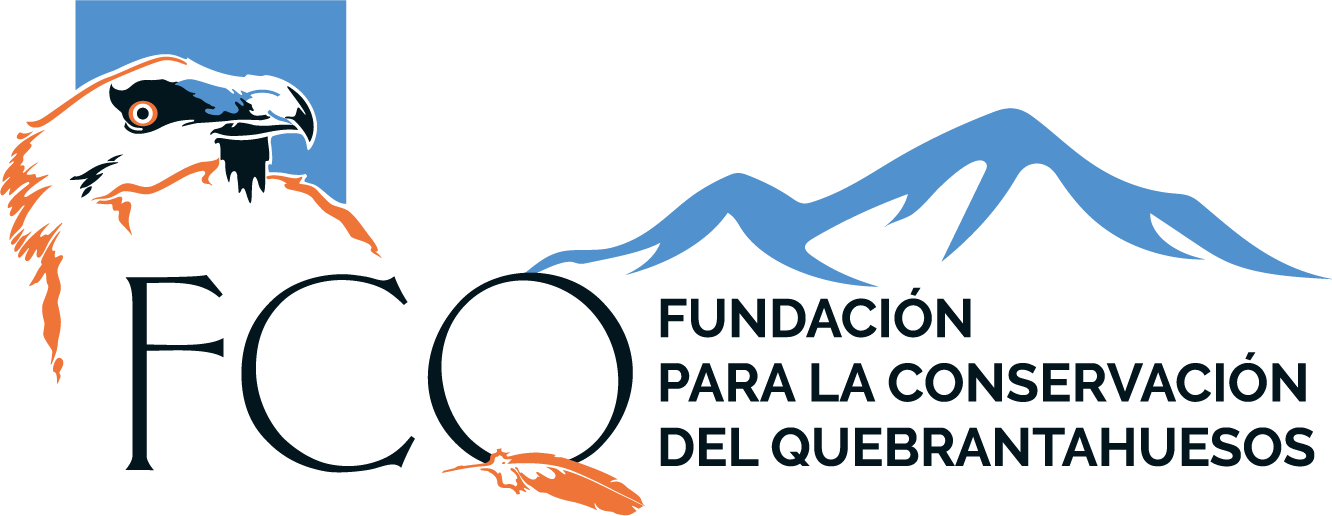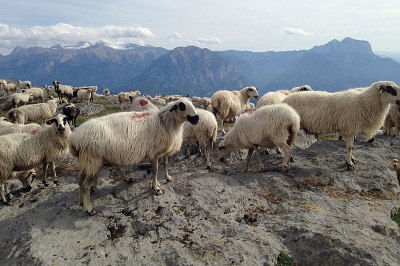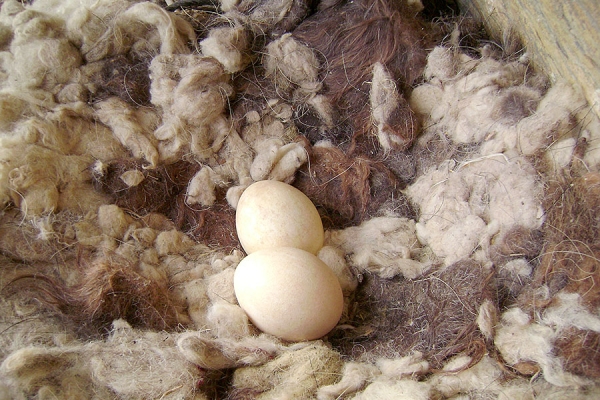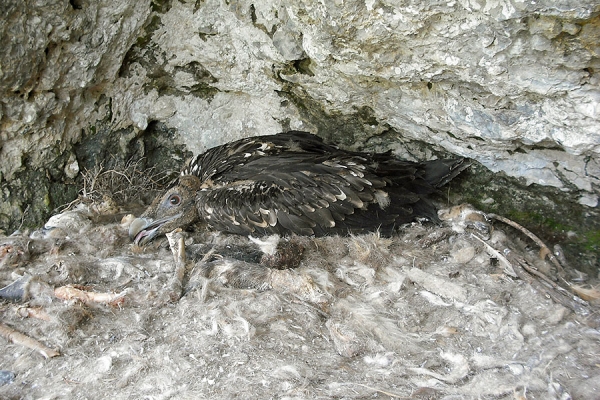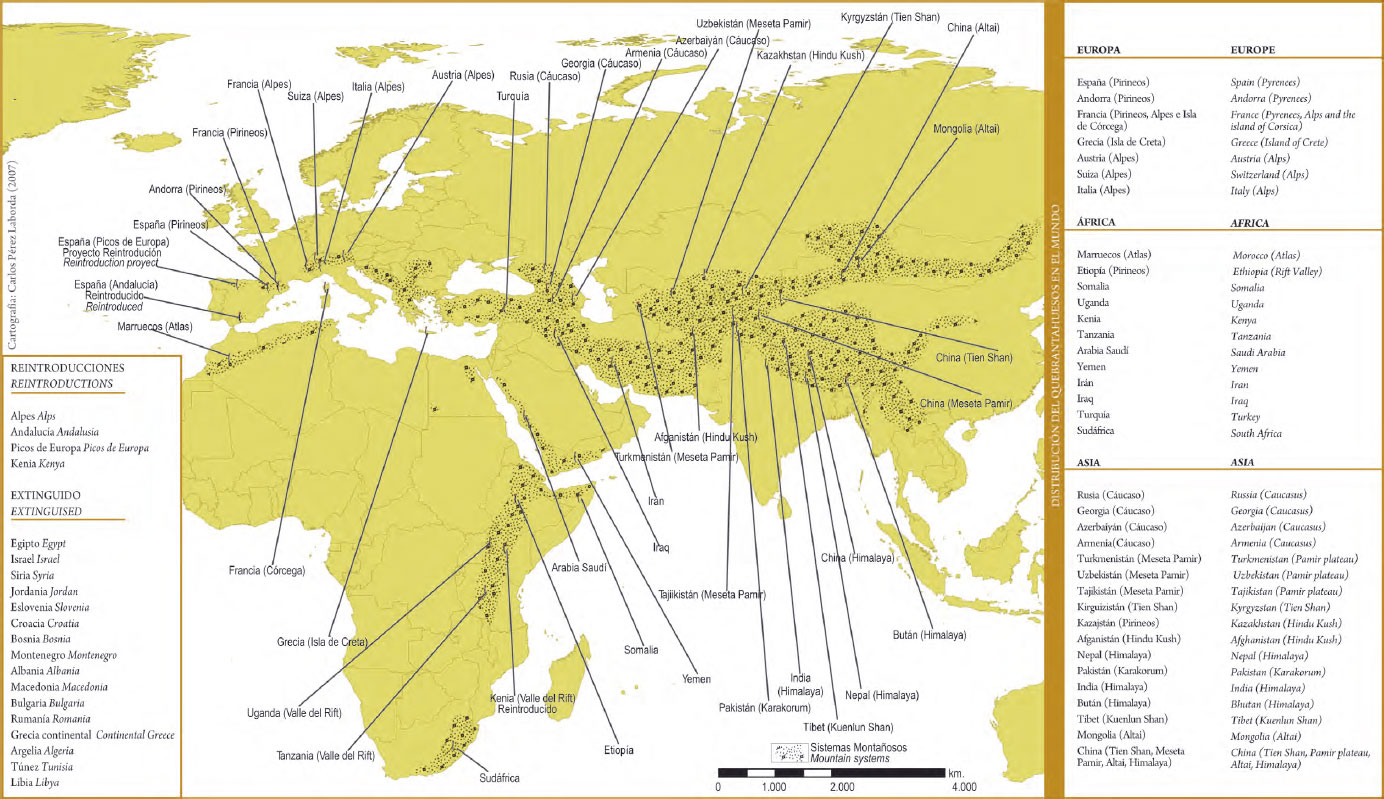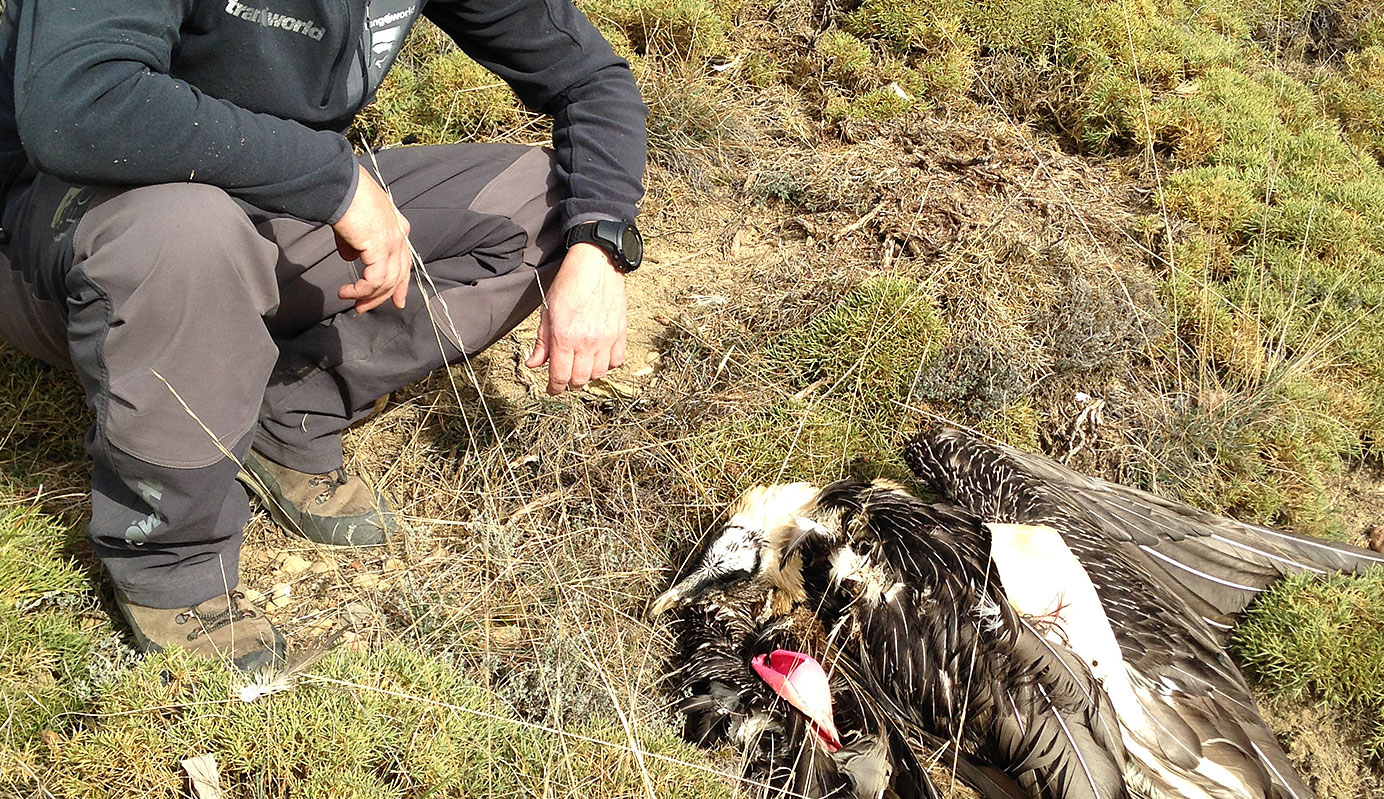The Bearded Vulture
Its scientific name Gypaetus barbatus alludes to its body appearance (from the Greek “Gyps”: vulture and “aetos”: eagle and from the Latin “barbatus” due to the beard that protrudes under its beak). It has eyes surrounded by a red sclerotyl ring, which stands out more when the specimen is more aggressive or nervous. A black mask extends from the eyes to the base of the beak, where filoplumes (beards) appear. On the top of the head there are black feathers that form a hood. The tail is wedge-shaped or diamond-shaped and the tarsi are covered with feathers. It has different types of plumage depending on age (juvenile, subadult and adult). They have the same color for both sexes, in the case of adults orange due to the habit of dyeing their plumage with mud.
Ages
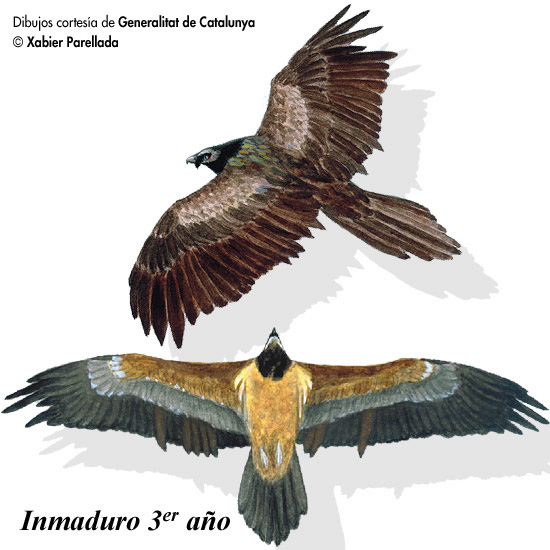
Youth from 1 to 3 years old
Black head and neck. Visible beard. Yellow iris. Back, with dorsal shield that is blurred. Irregular flight silhouette (old feathers longer and pointed, new feathers rounded and shorter).
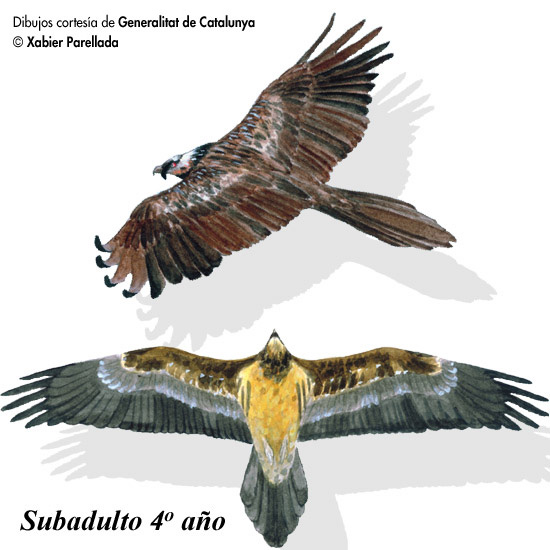
Subadult 4 to 6 years old
Light head and long beard. Yellow-white iris. Flight silhouette similar to that of the adult, with long, narrow wings and long tail.

Adult 7 years old
Orange head and neck. Black back. Chest (with a thin black collar), belly and tights of uniform appearance and orange color (depending on the mud baths). Silhouette of stylized flight.
Feeding
The lammergeier is a scavenger bird specialized in feeding on bone remains. Its wide oral commissure and the possession of a large number of acid-secreting cells facilitate the digestion of bones. Wild ungulates (Rupicapra) and domestic cattle (Ovis and Capra) are the main food source for the lammergeier in the Pyrenees. During the rearing of the chickens, the remains of domestic and wild ungulates can account for 67% of the food intake. Its common name “Bearded Vulture” comes from the particular technique it has for ingesting food. This technique consists of breaking the large bones, which cannot be swallowed, to break them into pieces of adequate size for ingestion, which are thrown from the air in rocky areas that we call “breakers”.
Reproduction
The lammergeier has a long reproductive cycle, divided into several stages: pre-laying (September-November), incubation (December-February), rearing (March-August) and emancipation of the chicks (January). During the pre-laying period, the species carries out activities related to nest construction (preferably in caves), territorial defense and sexual activity. The material provided to the nests is mainly composed of branches and wool, the latter being essential for maintaining the nest temperature during incubation. Laying can be of one or two eggs, with the average laying interval between the first and second egg being about six days. They lay in the middle of the winter period, thus coinciding the end of reproduction with the period that provides the greatest reproductive success.
The species mates at an average age of seven years, and first reproduction (attempted laying) occurs at 8-10 years of age. Both males and females permanently cover the clutch, with the percentage of interruption not exceeding 5%, due to the high risk of death to which the embryo is subjected, due to low temperatures or the possibility of predation. The average incubation time from laying is 53 days. In the case of hatching two chicks, aggression from the first hatched chick to the second hatched chick has been observed, which contributes to a reduction in the number of broods and starvation of the second chick. The average age at which the chick leaves the nest is 120 days. The reproductive units (RU) can be composed of two or three adults, in the latter case there are usually two males and one female (polyandrous trios), although exceptionally there have been observed RU formed by four individuals and two females and one male (polygynous trios). Each of these URs exploits an area of 100 to 300 km². The nesting areas are territorially defended from other specimens, with a range of distances between occupied nests from a minimum of 3 km to a maximum of 28 km.
Juvenile dispersion
Pre-adults carry out dispersive movements both in the Pyrenees and towards other mountain massifs: Picos de Europa, Iberian System, etc. Possibly, one of the most critical stages of their life cycle is the juvenile dispersion, a period that can be defined as the permanent movement that a specimen makes from its place of birth to the place where it reproduces or could reproduce, if it has survived and has found another individual. In most raptors, juveniles are more likely to make longer movements, since a significant proportion of adults are territorial. Pre-adult birds tend to concentrate on the southern slopes of the Pyrenees (January-April), with dense nuclei around the Supplementary Feeding Points (SFPs). The four to five year-old specimens are the ones that make the greatest movements in the Cordillera, but when they reach seven years of age, there is a decrease in the dispersion radius, especially between October and December, possibly due to territorial behavior. It is very significant, in this age group, the appearance of activity centers in the western and eastern ends of the Cordillera, which could favor the stable settlement of important population centers in these segments of the Pyrenees; in addition, and in the specific case of the western nucleus (Navarra and Basque Country), its consideration as an authentic geographical bridge between the Pyrenees and other mountain territories of the Iberian Peninsula (Cantabrian Mountain Range) could be of great importance and strategic interest for the management of the species.
Habitat
It is a species present in mountain areas, with a preference for those where there are open spaces and areas with steep cliffs and walls. Its presence coincides with the existence of populations of wild ungulates and domestic livestock, which are its main source of food.

Pyrenees
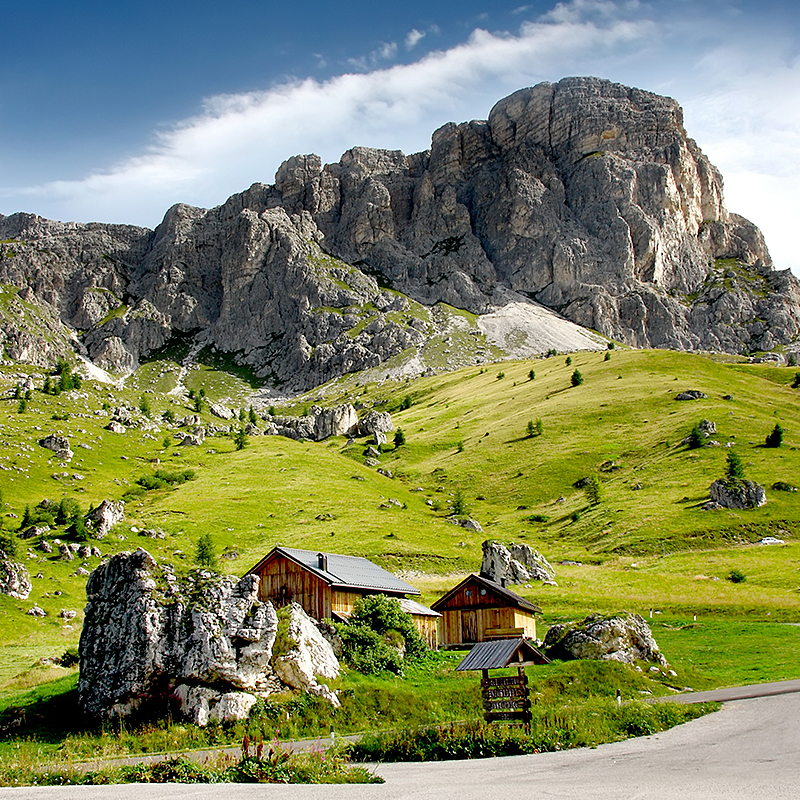
Alps

Himalaya
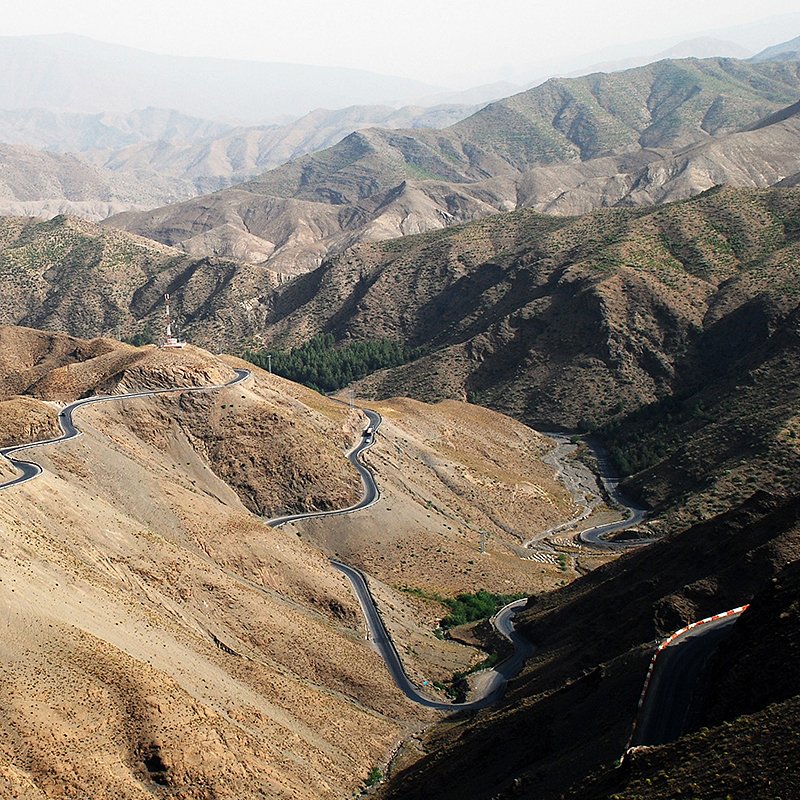
Atlas
Distribution and population
It is a territorial vulture present in some mountainous regions of Europe, Asia and Africa, occupying between 1 and 10 million km2 and with an estimated population of between 10,000 and 100,000 individuals. Two subspecies G. b. barbatus which is the most widespread and is found in the main mountain ranges of Eurasia and North Africa (Atlas, Pyrenees, islands of Corsica and Crete, Asia Minor, Middle East, Caucasus, Iran, Hindu Kush, Tian Shan, Altai, Pamir Plateau, Karakorum, Kuen Lun and Himalaya) and G. b. meridional The main distinguishing feature of the two subspecies is the absence of black feathers in the auricular region of G. auris, which is distributed in some mountains of southern and eastern Africa, mainly in Ethiopia (Abyssinian range) and South Africa (Drackensberg range), as well as in some isolated mountainous enclaves in Kenya and Tanzania. The main distinguishing feature of both subspecies is the absence of black feathers in the auricular region of G. b. meridionalis .
Actualmente tan solo se conocen adecuadamente las poblaciones de la UE: Pirineos, Alpes, Córcega y Creta y Sudáfrica.
Threats
During the last centuries, the western Palearctic populations have undergone a drastic process of regression, leading to their decline and extinction in most of the areas where they were present: Sicily (1840), Carpathians (1940), Alps (1935), Cyprus and Sardinia (1975) and Balkans (2000). The bearded vulture is considered one of the most endangered birds in Europe. In recent years it has been the subject of conservation plans in different European countries. In Spain it is a species catalogued as “in danger of extinction”. Factors that negatively affect the conservation of the species are unnatural mortality (poisoning and power lines), habitat loss, reduction of food resources and breeding failures due to human disturbance (hunting, sporting activities).
Where can they be seen?
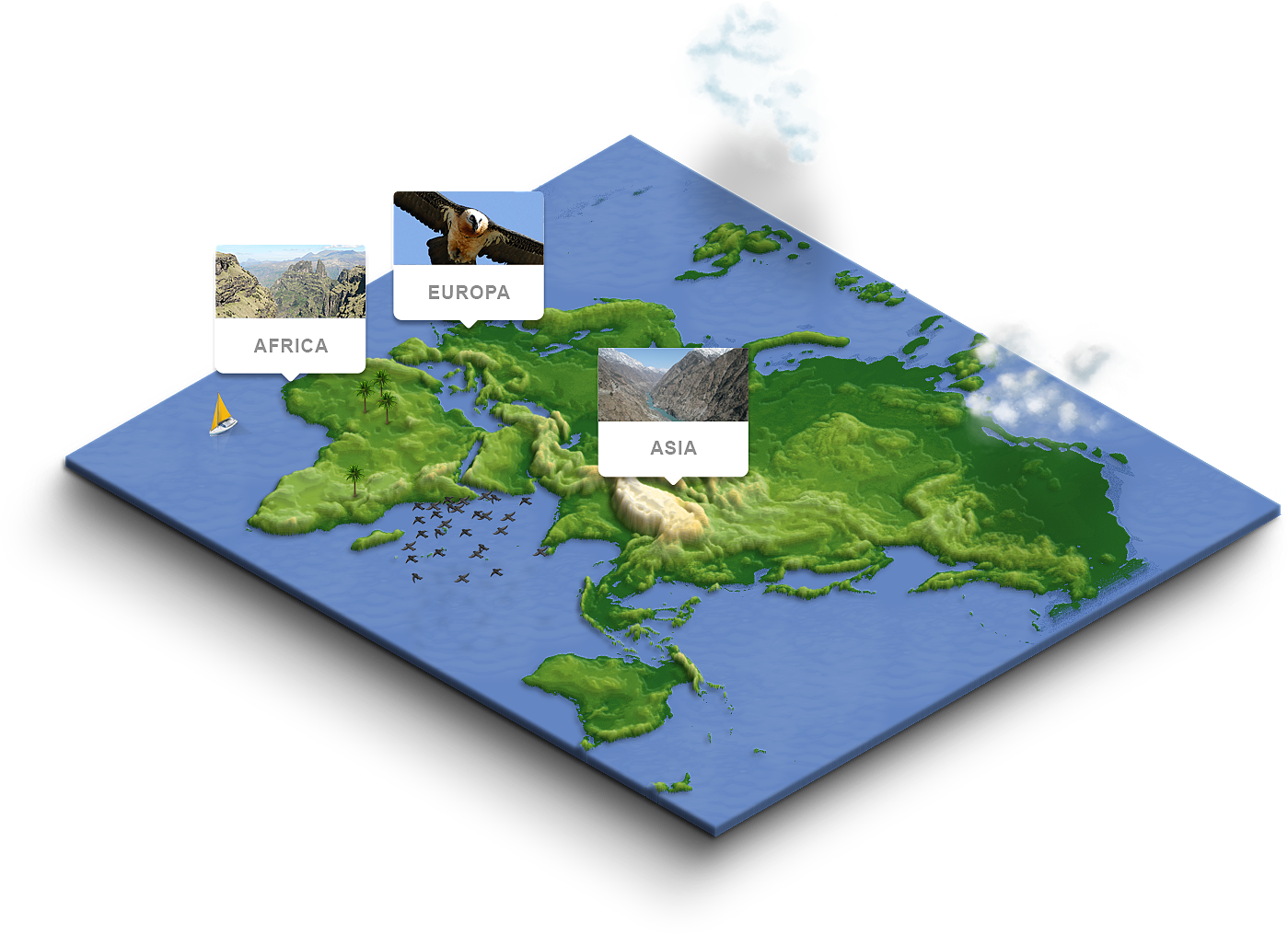
In order to update it and share it with all the people interested in the Bearded Vulture, we offer this portal for those who wish to collaborate with their travel observations in its distribution area. You can contribute a lot by sending us your information by e-mail to fcq@quebrantahuesos.org.
Contribution of comments
The information on the distribution and status of the bearded vulture in the world is basic for its conservation, being scarce and dispersed. In order to update it and share it with all the people interested in the bearded vulture, please collaborate with your travel observations of its populations and distribution area. In this section should not be part of sighting, should go in tracking of bearded vultures. Your information is valuable, you can send an e-mail to: fcq@quebrantahuesos.org Send an account of your experience with the following data:
- Location (Mountain range or place, locality and country)
- Observers
- Bird information (number and age of birds, behavior, absence of the species and threats)
- Other species or comments that you consider of interest
Tracking of bearded vultures tagged in the Pyrenees and Cantabrian Mountains
CITIZEN SCIENCE
What is it for?
The study of many of the issues that are considered a priority in the conservation of species (survival, vital areas, juvenile dispersal, obtaining samples for genetic and toxicological analysis, etc.) involves the capture, marking and monitoring of the species.
Who and how?
Since 1994, bearded vultures have been captured and marked in the Pyrenees using different systems: in the nest, with a cannon net and in wildlife recovery centers.
Types of marks
Short-term markings (feather discoloration) and long-term markings (metal rings, PVC, wing bands and VHF and satellite radio-transmitters) have been applied. The total weight of the material applied is calculated so as not to exceed 5% of the bird’s weight.
Ground tracking
Carried out through visual observations by FCQ technicians and volunteer observers, and by telemetric radio-tracking at dominant points and near the feeding sites of necrophagous birds.
Satellite tracking
Carried out by attaching satellite GPS (Global Position System) transmitters to the birds, which gives information about the exact position of the individuals, their hunting areas and their movements.
Satellite tracking
Carried out by attaching satellite GPS (Global Position System) transmitters to the birds, which gives information about the exact position of the individuals, their hunting areas and their movements.
Some results obtained and applications to management
- It has been possible to estimate the size of the pre-adult population and its survival.
- Injured specimens have been located , subsequently recovered and released .
- The causes of mortality have been identified: power lines, poisoning, diseases, etc., and subsequent management measures have been applied to solve them.
- Juvenile and natal dispersal patterns have been described .
- It has been possible to take legal action in cases of unnatural mortality of specimens.
- The tagging program has contributed information in the elaboration of scientific publications on the species, with solutions for its proper management .
Suscríbete a nuestra newsletter
Tus datos serán gestionados por la Fundación para el envío de boletines informativos periódicos a través de la plataforma Mailchimp. Tus datos nunca serán compartidos con terceros. Para más información, accede a nuestra Política de privacidad.
